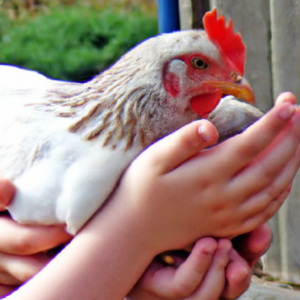
So you’ve decided to add a new nesting box to your flock of chickens, but now you’re wondering how to go about introducing it without causing any feathers to ruffle. Well, fear not, because in this article, we’ll explore some simple and friendly ways to introduce a new nesting box to your feathery friends. From enticing treats to strategic placement, we’ve got you covered. So sit back, relax, and get ready to make your flock feel right at home with their brand new cozy accommodation. It’s time to keep those eggs rolling in!

Preparing the New Nesting Box
Choosing the right location
When preparing a new nesting box for your flock, it’s important to choose the right location. The ideal spot should offer privacy and be situated in a quiet and calm area. Consider placing the nesting box away from high traffic areas and predators to ensure the safety and comfort of your chickens. Additionally, ensure the nesting box is located in an area with good ventilation to prevent the buildup of unpleasant odors.
Cleaning and disinfecting the nesting box
Before introducing the new nesting box, it’s crucial to thoroughly clean and disinfect it. Remove any old bedding and debris from the box and scrub the surfaces with a mild detergent and warm water. Rinse the nesting box thoroughly to remove any soap residue. Once clean, use a disinfectant approved for poultry use to sanitize the nesting box and kill any potential pathogens. Allow the nesting box to dry completely before proceeding.
Adding fresh bedding material
After the nesting box has been cleaned and disinfected, it’s time to add fresh bedding material. Choose a suitable bedding option such as straw, wood shavings, or hay. Spread a generous amount of bedding material in the bottom of the nesting box to provide a comfortable and cozy environment for your chickens. Ensure that the bedding is thick enough to cushion the eggs and absorb any moisture. Remember to regularly change the bedding to maintain cleanliness and prevent the buildup of bacteria.
Announcing the New Nesting Box
Introducing the new nesting box during a calm period
To ensure a smooth transition, it is best to introduce the new nesting box to your flock during a calm period. This can be during their usual resting or sleeping time. By choosing a time when the chickens are relaxed, it minimizes the likelihood of stress or resistance. Avoid introducing the nesting box during feeding time or when the chickens are otherwise occupied to prevent distractions.
Placing the new nesting box in a visible location
When announcing the new nesting box to the flock, it’s essential to place it in a visible location. Chickens are naturally curious creatures, and by making the nesting box easily noticeable, it will pique their interest. Consider positioning the box in a well-lit area where the chickens frequently gather. This will make it more likely for them to investigate and explore the new addition to their environment.
Providing positive reinforcement and rewards
To encourage the use of the new nesting box, it’s important to provide positive reinforcement and rewards. Whenever a chicken investigates or uses the nesting box, offer praise and a small treat. This positive association will reinforce the behavior and make the chickens more likely to continue using the new nesting box. Remember to be patient and consistent with the rewards, as it may take time for the chickens to fully adjust to the new setup.

Guiding the Flock to the New Nesting Box
Blocking access to the old nesting boxes
To guide the flock to the new nesting box, it’s necessary to block access to the old boxes. Chickens are creatures of habit, and if given the option, they may continue using their familiar nesting spots. Block off the entrance to the old boxes using chicken wire or a temporary barrier. This will redirect the chickens towards the new nesting box and encourage them to explore and utilize it.
Creating a gradual transition period
To ease the transition for the flock, it’s recommended to create a gradual transition period. Start by gradually reducing the number of old nesting boxes available to the chickens. Remove one box at a time and allow the chickens to adjust to the reduced options. Eventually, transition to only having the new nesting box available. This gradual process will help the chickens adapt to the change more easily and reduce any potential stress.
Using bait to attract the chickens to the new nesting box
As an additional enticement, you can use bait to attract the chickens to the new nesting box. Place a few tasty treats, such as mealworms or kitchen scraps, inside the nesting box. The enticing smell and sight of the treats will pique the curiosity of the chickens and encourage them to explore the box further. Remember to replenish the bait regularly to maintain interest and reinforce the behavior of using the new nesting box.
Ensuring Comfort and Familiarity
Adding some eggs in the new nesting box
To make the new nesting box more appealing, consider adding some eggs in it. The sight of eggs can trigger a nesting instinct in chickens and entice them to investigate the box further. Use dummy or previously collected eggs to avoid wasting fresh eggs. By mimicking a nesting environment with eggs, you are creating a familiar and inviting space that the chickens will be more inclined to use.
Transferring nest material from the old boxes
To further enhance the comfort and familiarity of the new nesting box, transfer some nest material from the old boxes. Chickens have individual preferences for nest material, and the familiar scent can help put them at ease in the new location. Take a small amount of the bedding material from the old boxes and sprinkle it in the new nesting box. This will help create a sense of continuity and encourage the chickens to use the new space.
Maintaining a consistent and comfortable environment
To ensure the chickens continue using the new nesting box, it’s important to maintain a consistent and comfortable environment. Regularly clean and change the bedding material to maintain cleanliness and prevent any odors that may deter the chickens. Additionally, ensure the nesting box is large enough to accommodate the chickens comfortably. A cramped or uncomfortable space may discourage the use of the nest, so periodically check and adjust the size as needed.

Monitoring and Troubleshooting
Observing the behavior of the flock
Once the new nesting box has been introduced, it’s important to closely observe the behavior of the flock. Pay attention to whether the chickens are showing interest in the new nest, if they are exploring it, and if any eggs are being laid inside. Observe the chickens’ body language and interactions with the nesting box to assess their comfort level and acceptance of the new environment. Regular observation will allow you to address any issues or conflicts promptly.
Ensuring all chickens have adjusted to the new box
As you monitor the flock’s behavior, it’s crucial to ensure that all chickens have adjusted to the new nesting box. Some chickens may take longer to transition than others, so patience is key. If you notice any chickens consistently avoiding the new nest or showing signs of distress, take steps to address their concerns and encourage their use of the box. Allowing sufficient time for all chickens to adjust will promote harmony within the flock.
Addressing any issues or conflicts
In the event of any issues or conflicts arising from the introduction of the new nesting box, it’s essential to address them promptly. For example, if there is pecking or aggression towards a certain chicken in the nesting box, it may be necessary to separate or reintroduce them to the flock gradually. Addressing conflicts and providing individual attention where needed will help maintain a peaceful and productive environment for your chickens.
Encouraging Nest Box Use
Offering treats or incentives near the new box
To encourage nest box use, offer treats or incentives near the new box. Place a small dish of treats such as grains, seeds, or mealworms in close proximity to the nesting box. The enticing aroma and visual cues will attract the chickens’ attention and motivate them to investigate the area. Gradually move the treats closer to the nesting box to create a positive association and encourage chickens to use the box regularly.
Using visual cues or signs to attract the chickens
Another effective method to encourage nest box use is by using visual cues or signs. Attach a brightly colored flag or sign near the nesting box to catch the chickens’ attention. You can also place a few fake eggs or a ceramic nesting hen in or near the box to simulate a nesting area. These visual cues will stimulate the chickens’ nesting instincts and make the new box more appealing and inviting.
Ensuring the box is clean and inviting
It is crucial to maintain a clean and inviting nesting box to encourage its use. Regularly clean and inspect the box, removing any debris or soiled bedding. Replace the bedding material when necessary to maintain cleanliness and prevent the spread of bacteria. A clean and well-maintained nesting box provides a comfortable and attractive environment, increasing the likelihood of chickens choosing to use it for nesting.
Dealing with Reluctant Chickens
Providing individual attention and training
If you have chickens that are particularly reluctant to use the new nesting box, providing individual attention and training can be beneficial. Spend time with the hesitant chickens, gently guiding them towards the nesting box and offering treats as a reward for positive behavior. Repeat this process consistently until the chickens become more comfortable and familiar with the new nest. Patience and persistence will help overcome their reluctance.
Placing a broody hen in the new nesting box
A broody hen can play a significant role in encouraging reluctant chickens to use the new nesting box. Broody hens have a strong nesting instinct and can help create a sense of safety and familiarity for the other chickens. Place a broody hen in the new nesting box and allow her to demonstrate proper nesting behavior. The presence of a broody hen can inspire other chickens to follow suit and use the nesting box.
Adjusting the environment to suit their preferences
In some cases, reluctant chickens may have specific preferences that need to be addressed to encourage the use of the new nesting box. Experiment with different bedding materials or nest box designs to find what suits the chickens’ preferences. Some chickens may prefer a more secluded or covered nest box, while others may prefer an open and airy space. By catering to their individual preferences, you can create an environment that the chickens find comfortable and appealing.
Preventing Nest Box Competition
Providing multiple nesting boxes
To prevent nest box competition, provide multiple nesting boxes for your flock. The recommended guideline is to have one nesting box for every 4-5 hens. Having sufficient nesting boxes ensures that each hen can access a nest without feeling the need to compete or establish dominance. The availability of multiple boxes reduces stress and minimizes pecking order conflicts among the chickens.
Ensuring sufficient space between boxes
When setting up multiple nesting boxes, it’s essential to ensure sufficient space between them. Chickens value privacy when laying eggs, so spacing the boxes apart creates separate and secluded areas for each hen. Provide enough distance between the boxes to prevent any territorial disputes and allow each hen to choose their preferred nesting spot comfortably. Adequate spacing helps maintain a calm and harmonious environment within the flock.
Managing pecking order and hierarchy
Within a flock, a pecking order and hierarchy naturally exist among the chickens. It’s important to be mindful of this when introducing multiple nesting boxes. Dominant or higher-ranking hens may claim certain boxes as their preferred nesting spots, potentially causing conflicts among the flock. Monitor the chickens’ behavior closely and intervene if needed, ensuring that all hens have access to the nesting boxes while maintaining harmony within the flock.
Maintaining Hygiene and Cleanliness
Regularly cleaning and inspecting the nesting box
To maintain hygiene and cleanliness, it is crucial to regularly clean and inspect the nesting box. Remove any soiled bedding, debris, or leftover food from the box on a regular basis. Thoroughly scrub the nesting box with a mild detergent and warm water, ensuring all surfaces are clean. Check for any signs of wear or damage and repair or replace as necessary. Regular cleaning and inspection help prevent the buildup of bacteria and maintain a healthy environment for the chickens.
Replacing bedding material when necessary
Bedding material in the nesting box should be replaced when it becomes soiled or begins to emit a foul odor. Regularly check the bedding for signs of mold, dampness, or pests, which can indicate the need for replacement. Clean, dry, and fresh bedding material provides a comfortable and hygienic environment for the chickens and helps prevent health issues or infections. Replace the bedding promptly to maintain the cleanliness and well-being of your flock.
Removing any eggs that are not collected promptly
Promptly removing any eggs laid in the nesting box is essential for maintaining hygiene. Leaving eggs in the nest for an extended period can lead to breakage, spoilage, or even attract pests. Collect eggs from the nesting box at least once or twice a day to ensure they are fresh and clean. Proper egg collection prevents the spread of bacteria and encourages chickens to continue using the nesting box for laying.
Adapting to the Flock’s Preferences
Making adjustments based on their choices
Each flock is unique, and individual chickens may have specific preferences when it comes to nest box use. Observe the behavior and choices of your flock and make adjustments accordingly. If the majority of the chickens show a preference for a particular nesting box layout or location, consider accommodating their preferences. By adapting to their preferences, you create an environment that is most suited to their needs and encourages natural nesting behavior.
Experimenting with different nesting box designs
To cater to the flock’s preferences, consider experimenting with different nesting box designs. Some chickens may prefer a nesting box with a low entrance, while others may prefer a higher entrance for added privacy. Test out different materials, sizes, and arrangements to determine what the chickens favor. By providing options and allowing for experimentation, you can find the right nesting box design that satisfies the flock’s individual preferences.
Observing and adapting to individual chicken behavior
Chickens have unique personalities and interests, so it’s important to observe and adapt to their individual behaviors. Pay attention to each chicken’s nesting habits and preferences, noting which boxes they prefer or if they exhibit any specific behaviors when using the nesting box. By recognizing and accommodating these individual behaviors, you can foster a sense of comfort and satisfaction among your chickens, ultimately promoting improved nest box use.
Introducing a new nesting box to the flock requires careful planning, consideration, and patience. By following these steps and taking into account the preferences and comfort of your chickens, you can successfully introduce and establish a new nesting box that meets the needs of your feathered friends. Remember to regularly monitor and maintain the nesting box to ensure a clean and comfortable environment for your flock. With time, positive reinforcement, and a bit of adjustment, your chickens will happily embrace their new nesting accommodations.







